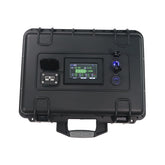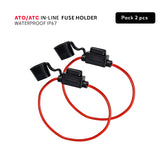Complete Guide to Solar Panel Wiring: 12V to 48V
Wiring Diagrams for 12V to 48V Solar Panels
1. Reminder: Installation Steps
Step 1 - Secure the Charge Controller: Secure the charge controller in a safe and accessible place. Make sure it is well-ventilated and protected from the weather. The controller should be close to the batteries to minimize cable length.
Step 2 - Connect the Batteries: Connect the batteries, respecting the polarities. Use cables of appropriate gauge to support the current of your system. Ensure the connections are tight and secure.
Step 3 - Connect the Solar Panel: Connect the solar panels to the controller following the chosen wiring diagram (series or parallel). Use MC4 connectors for a secure and efficient connection. Check the connections to avoid current loss.
2. 12V Setup
The 12V setup is the most common standard for onboard solar installations, especially on boats. This choice is due to its native compatibility with most marine electrical equipment, without requiring voltage converters. It simplifies installation and reduces wiring errors.
Appreciated for its simplicity, the 12V system allows for quick and accessible maintenance, even in a constrained environment. It efficiently powers navigation instruments, autopilot, interior and exterior lighting, water pumps, and small onboard electronic devices.
Another major advantage: is the wide availability of 12V components, both for solar modules and accessories and protections. This standardization facilitates troubleshooting and optimizes equipment costs.
1 Panel

2 Panels in Parallel

The 2-way Y junctions with MC4 connector are available here: Ref PVC2Y
3 Panels in Parallel

The 3-way Y junctions with MC4 connector are available here: Ref PVC3Y
6 Panels – 2 MPPT

3. 24V Setup
24V is suitable for medium-power onboard installations. It reduces current intensity and thus line losses. MPPTs heat up less and 24V to 12V voltage reducers are now reliable and economical.
2 Panels in Series

4 Panels (2x2 series-parallel)

4. 48V Setup
48V has become the standard for powerful systems on catamarans and hybrid boats. It carries more power with less current, reducing losses and simplifying wiring.
It is also the maximum limit allowed before safety regulations become much more restrictive. 48V can power electric motors, large converters, and home automation without exposing to dangerous voltages. It is now well-mastered, with reliable components and good standardization.
6 Panels (2x3 in series)

5. MPPT vs. PWM Comparison
Charge controllers protect batteries and optimize the current produced. Two technologies: PWM (simple, reliable) and MPPT (more expensive but very efficient).
| Characteristic | MPPT | PWM |
|---|---|---|
| Overall Efficiency | Very high, especially in variable conditions | Less high, especially with high temperature |
| Shading (sails, clouds) | Dynamic optimization | Direct drop in production |
| Panel/Battery Compatibility | Panel voltage > battery possible | Requires close voltage |
| Panels in Series | Up to 3 or more | Limited to 1 or 2 |
| Reliability | Sensitive components, need configuration | Very reliable, no configuration |
| Recommendation | Boat with high consumption, catamaran, living aboard | Engine battery, wintering, 30–50W panel |
6. MC4 Connector Crimping Guide
Use quality MC4 connectors and an appropriate crimping tool:
- Strip the solar cable to 7 mm.
- Insert into the connector to the end.
- Crimp with force and regularity.
- Check the assembly (no play).
7. Tips and Tricks for a Successful Installation
- Use certified solar cable 4 mm² minimum.
- Protect each branch with an appropriate circuit breaker.
- Regularly clean the panels with clear water.
- Cover the panels when handling the cables.
- Always start by connecting the battery, then the panels.
- Monitor your installation with a battery monitor.
8. Conclusion and Additional Resources
For more information, consult our complete guide: Solar Installation on Boats – Ultimate Guide















